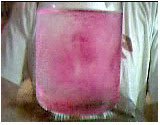


|
The convection phenomenon
Science at Home |
||
|
Materials
|
Compounds
|
Videos: download.avi (507 KB)
Pictures: 
|
|
Procedure
1. Pour distilled water in a beaker, filling 3/4 of its total volume. 2. Add some sodium permanganate crystals to the water. The water shouldn't become total colored. The permanganate crystals should be deposited in the bottom. (the permanganate should not be touched or ate because it is toxic. Use gloves and glasses!) 3. Place the beaker on the tripod and heat it up. (while the heating is being done you will begin to notice a migration of water from the base to top. That phenomenon is called convection heat transfer) |
||
|
Why?
One type of heat transfer is convection. The heat transfer studied in this experiment is the forced convection, which happens due to density differences. The water in the beaker will be heated in the base, being the highest temperature in the center of the base. That implies that the molecules, closer to the center of the base, have larger temperature than the molecules that are placed above them. That is, in the vertical axis of the beaker it exists a temperature gradient, reducing the temperature as it is arriving to the top water surface. It is noted that the gradient is not lineal because close to the beaker walls we have water with smaller temperature than in the center. This is the key for the forced convection phenomenon. We can follow the path of a molecule located in the center of the base, in the initial instant. When heating the molecule, its density will become less, implicating that it will move up. When moving up its temperature will decrease. The molecule moves up until it reaches the minimum temperature point. The minimum temperature point is close to the top and to the beaker walls. Of course the molecule is not going to the limit of the surface, because before arriving to that point its temperature will becomes lower enough in a way that it will become denser, and move immediately down. In the displacement to the hot base surface, the molecule will prefer the zone close to the walls because it offers a range of temperatures more favourable. Another reason, for the existence of a certain molecule path, is because in the central zone is where most of the hot molecules move upward, offering an extra resistance to the molecule that is moving down.
|
||
No part of this website can be reproduced without previous authorization. Please inform me if there is any problem with the website. |